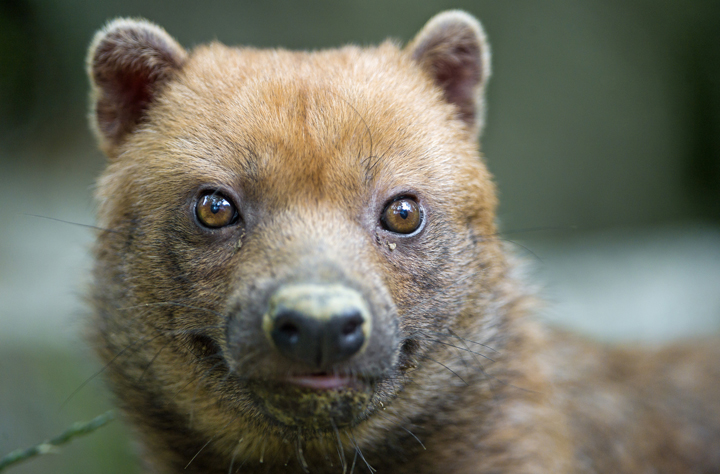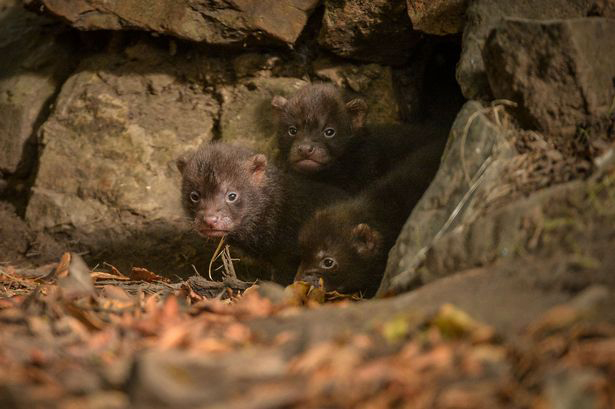Incredibly Cute, Frustratingly Elusive: Bush Dogs
New photo trap images from Panama give a tantalizing glimpse of these cat-sized dogs of Central and South America.
By Vicki Croke

Bear cub? No…this is a bush dog. Rarely seen in the wild, this photo was taken in a French zoo. Photo: Tambako The Jaguar.
Chances are you’ve never heard of them.
Not much bigger than house cats, they look more like obese mongooses or little bear cubs than dogs, and yet they are card-carrying members of the canid family. And, according to a new Smithsonian study, just published in the journal Canid Biology and Conservation, though these highly-social and web-footed wild dogs are widespread in Panama, they are seldom seen by the people who live there or by automated camera traps set up in remote areas of the forest.
How seldom?
Well, “to give some idea of the difficulty of studying the species,” according to a statement from the Smithsonian Tropical Research Institute, “photos were obtained on only 11 occasions out of more than almost 32,000 camera-days (the number of cameras multiplied by the number of days they were in operation).”

One of the rare camera trap photos of bush dogs. This one from the wet tropical forests of Pirre, Darién Province, Panama, March 20, 2015 at 09:44h. Credit: GEMAS Panamá , Fundación Natura, Fondo Darién, Fundación Yaguará Panamá, Southern Illinois University.
Even the people who research them call them “enigmatic.”
A co-author of the study, Smithsonian Research Associate Ricardo Moreno, said, “Our group of biologists from Yaguará Panama and collaborators are working on an article about big mammals using camera trapping data that spans Panama from the Costa Rican border to the Colombian border. The bush dog is one of the rarest species that we photograph.”
Bush dogs are found from Central to South America. But, according to STRI, “The International Union for Conservation of Nature has estimated that bush dog populations have declined by up to 25 percent in the past 12 years, and has classified it as ‘near-threatened’ globally.”
Three bush dogs were filmed by a camera trap in Amapá National Forest, Eastern Brazilian Amazonia in 2014. Courtesy of Wild Canids.
What’s causing that? STRI says that “unlike other some other carnivores in Panama, such as jaguar, puma and coyote, bush dogs do not appear to be directly persecuted by humans.”
The big problem is that they are losing their turf. “Fifteen percent of Panama’s forests were lost between 1990 and 2010,” the organization says. And, “bush dogs have very large home ranges for animals of their size, as much as 270 square miles, and they may require large tracts of forest to survive. Other threats include reduction of the abundance of their prey from hunting by humans and exposure to diseases carried by dogs used by hunters.”
It might be hard to save something you never see, but with their status considered near-threatened, scientists are calling for measures to help these odd, intriguing creatures.
The camera trap data will help Smithsonian with conservation planning for this elusive animal. The traps were set up at a number of remote sites and, according to Smithsonian, they “fortuitously snapped photos of bush dogs at four sites ranging from Cerro Pirre near the Colombian border in eastern Panama, to Santa Fe National Park in the western part of the country.”
The photos give us tantalizing glimpses of an elusive species.
“Bush dogs, Speothos venaticus, are short-legged and stubby, standing only about a foot tall at the shoulder,” according to Smithsonian. “They live mainly in tropical forests but have also been recorded in fragmented and altered habitats. Hunting in packs of up to 10 animals, bush dogs give high-pitched whines to maintain contact and yap like puppies when they chase their prey. They feed mostly on large forest rodents like agoutis and pacas, but at one site in Brazil, they mainly ate armadillos. Fierce for their size, a pack of six once was seen chasing a tapir, an animal almost 20 times a bush dog’s weight. Although active by day, bush dogs are remarkably hard to see and are very rarely reported even where they are known to occur.”
Found in zoos around the world, including those in Detroit, St. Louis, and Atlanta here in the US, bush dogs are being bred successfully in captivity. Little is known about their behavior in the wild.



2 Responses to “Incredibly Cute, Frustratingly Elusive: Bush Dogs”
They ARE cute!! However, I bet their bite isn’t so delightful.
I hope there is something done about their dwindling numbers so we can write about them for centuries to come.
@Michael Bishop re.🌳-🐶: ❤️!👍🏼!
Comments are closed.